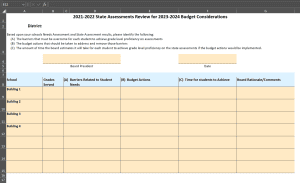Unified School District 434 Santa Fe Trail appears to be in violation of state law K.S.A. 72-1163, which requires local school boards to conduct annual needs assessments in each school and publish the findings on the district’s website.
In response to a request under the Kansas Open Records Act asking for the last few years’ worth of needs assessments, the district sent a set of documents that the Department of Education recommends but not the template it provides to meet the requirements of the law.
State law requires that the annual building needs assessments — which are to be used to inform budget decisions — must include:
- (A) The barriers that must be overcome to have all students achieve proficiency — above Level 2 on the state assessment– for proficiency in reading and math.
- (B) The budget actions required to overcome such barriers, including, but not limited to, recommendations on the reallocation of resources.
- (C) the amount of time the local school board estimates it will take for all students to achieve proficiency above level 2 if such budget actions are implemented.
The Kansas State Department of Education provides a very simple template (below) for the above information, which the documents provided by Santa Fe Trail do not have, despite repeated protestations to the contrary.

When the Sentinel asked — several times — for Board Clerk Amy Hill to provide documents that had the information required by state law, she insisted, “The documents supplied by the district are responsive to your request.”
State law also requires the district board of education to review the needs assessment reports and sign a document certifying that it has done so. The Sentinel asked Hill on Wednesday, May 8, to provide the form the board signed and the reports they reviewed.
As of publication, Hill has not responded to the email.
Large achievement gaps at Santa Fe Trail
One question on the other KSDE template asks if there are gaps in student success among race/ethnicity student subgroups. Such gaps are important to note and address, but KSDE does not ask if there are gaps for low-income students. Education officials stress that income-based gaps are the most important to address, as income is a greater factor than race on achievement.
KSDE officials also know that many schools do not have reportable levels of race/ethnic groups (more than ten students to ensure privacy), making it seem that KSDE is consciously hiding income-based achievement gaps.
The report for the Carbondale Attendance Center at Santa Fe Trail says there are no race or ethnic achievement gaps, but some do exist.
For instance, state assessment results for Carbondale show 39% of white students are below grade level in math, and only 19% are proficient. Thirty-two percent of Hispanic students are below grade level, and 18% are proficient. Among multi-racial students, 32% are below grade level, and 33% are proficient.
Results for Black students are not listed.
The income-based gaps jump alarmingly, however.
District-wide at Santa Fe Trail, 54% of low-income (defined as free and reduced-price lunch) students are below grade level in math, 34% are at grade level but need remedial training, and only 12% are proficient.
Among students who are not low-income, 31% are below grade level, and 25% are proficient in math.
The numbers track similarly at Carbondale, with 52% of low-income students below grade level in math and only 11% proficient.
Among those who are not low-income, 27% are below grade-level, and 27% are proficient.




